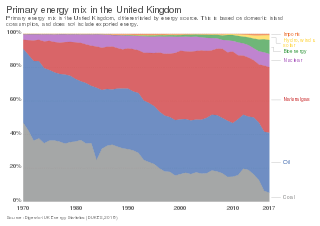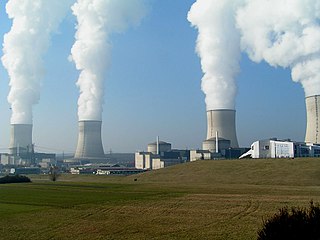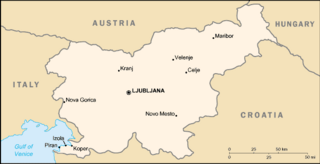Related Research Articles
The Renewables Obligation (RO) is designed to encourage generation of electricity from eligible renewable sources in the United Kingdom. It was introduced in England and Wales and in a different form in Scotland in April 2002 and in Northern Ireland in April 2005, replacing the Non-Fossil Fuel Obligation which operated from 1990.

Japan's primary energy consumption was 477.6 Mtoe in 2011, a decrease of 5% over the previous year. The country lacks significant domestic reserves of fossil fuel, except coal, and must import substantial amounts of crude oil, natural gas, and other energy resources, including uranium. Japan relied on oil imports to meet about 84% of its energy needs in 2010. Japan was also the first coal importer in 2010, with 187 Mt, and the first natural gas importer with 99 bcm. As of 2019, 88% of Japan's total primary energy supply came from fossil fuels.

Energy in the United Kingdom came mostly from fossil fuels in 2021. Total energy consumption in the United Kingdom was 142.0 million tonnes of oil equivalent in 2019. In 2014, the UK had an energy consumption per capita of 2.78 tonnes of oil equivalent compared to a world average of 1.92 tonnes of oil equivalent. Demand for electricity in 2014 was 34.42 GW on average coming from a total electricity generation of 335.0 TWh.

The energy policy of the United Kingdom refers to the United Kingdom's efforts towards reducing energy intensity, reducing energy poverty, and maintaining energy supply reliability. The United Kingdom has had success in this, though energy intensity remains high. There is an ambitious goal to reduce carbon dioxide emissions in future years, but it is unclear whether the programmes in place are sufficient to achieve this objective. Regarding energy self-sufficiency, UK policy does not address this issue, other than to concede historic energy security is currently ceasing to exist.

The United Kingdom is the best location for wind power in Europe and one of the best in the world. The combination of long coastline, shallow water and strong winds make offshore wind unusually effective.

The production of renewable energy in Scotland is a topic that came to the fore in technical, economic, and political terms during the opening years of the 21st century. The natural resource base for renewable energy is high by European, and even global standards, with the most important potential sources being wind, wave, and tide. Renewables generate almost all of Scotland's electricity, mostly from the country's wind power.

Energy independence is independence or autarky regarding energy resources, energy supply and/or energy generation by the energy industry.

As of 2023, Europe had a total installed wind capacity of 255 gigawatts (GW). In 2017, a total of 15,680 MW of wind power was installed, representing 55% of all new power capacity, and the wind power generated 336 TWh of electricity, enough to supply 11.6% of the EU's electricity consumption.

Wind power is the fastest-growing renewable energy technology in Scotland, with 11,482 megawatts (MW) of installed wind power capacity by Q1 2023. This included 9,316 MW from onshore wind in Scotland and 2,166 MW of offshore wind generators.

Renewable energy in the United Kingdom contributes to production for electricity, heat, and transport.

Whitelee Wind Farm is a windfarm on the Eaglesham moor in Scotland. The main visitor centre is located in East Renfrewshire, but the majority of turbines are located in East Ayrshire and South Lanarkshire. It is the largest on-shore wind farm in the United Kingdom with 215 Siemens and Alstom wind turbines and a total capacity of 539 megawatts (MW), with the average of 2.5 MW per turbine. Whitelee was developed and is operated by ScottishPower Renewables, which is part of the Spanish company Iberdrola.

Scotland has a long history of nuclear research and electricity generation. Nuclear energy consistently accounts for 20-80% of the electric supply in Scotland depending on weather conditions for wind power generation and electricity demand. As of 2022, there is only one remaining operating nuclear power station in Scotland (Torness).

Climate change in Scotland is causing a range of impacts on Scotland, and its mitigation and adaptation is a matter for the devolved Scottish Parliament. Climate change has already changed timings of spring events such as leaf unfolding, bird migration and egg-laying. Severe effects are likely to occur on biodiversity.

Energy in Malta describes energy production, consumption and import in Malta. Malta has no domestic resource of fossil fuels and no gas distribution network, and relies overwhelmingly on imports of fossil fuels and electricity to cover its energy needs. Since 2015, the Malta–Sicily interconnector allows Malta to be connected to the European power grid and import a significant share of its electricity.

The United Kingdom has a National Grid that covers most of mainland Great Britain and several of the surrounding islands, as well as some connectivity to other countries. The electrical sector supplies power to consumers at 230 volts AC with a frequency of 50 Hz. In 2020 the electricity sector's grid supply came from 55% low-carbon power, 36.1% fossil fuelled power, and 8.4% imports. Renewable power is showing strong growth, while fossil fuel generator use in general and coal use in particular is shrinking, with historically dominant coal generators now mainly being run in winter due to pollution and costs, and contributed just 1.6% of the supply in 2020.

The electricity sector in France is dominated by its nuclear power, which accounted for 71.7% of total production in 2018, while renewables and fossil fuels accounted for 21.3% and 7.1%, respectively. France has the largest share of nuclear electricity in the world, and together with renewable energy supplies, this has helped its grid achieve very low carbon intensity.

Ireland is a net energy importer. Ireland's import dependency decreased to 85% in 2014. The cost of all energy imports to Ireland was approximately €5.7 billion, down from €6.5 billion (revised) in 2013 due mainly to falling oil and, to a lesser extent, gas import prices. Consumption of all fuels fell in 2014 with the exception of peat, renewables and non-renewable wastes.

Total primary energy supply (TPES) in Slovenia was 6.80 Mtoe in 2019. In the same year, electricity production was 16.1 TWh, consumption was 14.9 TWh.

World energy supply and consumption refers to the global primary energy production, energy conversion and trade, and final consumption of energy. Energy can be used in various different forms, as processed fuels or electricity, or for various different purposes, like for transportation or electricity generation. Energy production and consumption are an important part of the economy. A serious problem concerning energy production and consumption is greenhouse gas emissions. Of about 50 billion tonnes worldwide annual total greenhouse gas emissions, 36 billion tonnes of carbon dioxide was emitted due to energy in 2021.

In 2019, Wales generated 27% of its electricity consumption as renewable electricity, an increase from 19% in 2014. The Welsh Government set a target of 70% by 2030. In 2019, Wales was a net exporter of electricity. It produced 27.9 TWh of electricity while only consuming 14.7 TWh. The natural resource base for renewable energy is high by European standards, with the core sources being wind, wave, and tidal. Wales has a long history of renewable energy: in the 1880s, the first house in Wales with electric lighting powered from its own hydro-electric power station was in Plas Tan y Bwlch, Gwynedd. In 1963, the Ffestiniog Power Station was constructed, providing a large scale generation of hydroelectricity, and in November 1973, the Centre for Alternative Technology was opened in Machynlleth.
References
- 1 2 "Quarterly energy statistics bulletins". www.gov.scot. Retrieved 2022-03-03.
- ↑ "Whitelee wind farm in Scotland". iberdrola.com. Iberdrola. Retrieved 3 January 2024.
- ↑ "Scotland unveils world's largest tidal stream power project". ft.com. Financial Times. Retrieved 3 January 2024.
- ↑ "Scottish Energy Statistics Hub: Proportion of electricity consumption by fuel". scotland.shinyapps.io. Retrieved 7 October 2022.
- ↑ "The future of energy in Scotland: Scottish energy strategy". Gov.scot. Retrieved 3 January 2019.
- ↑ "Record renewable energy output". www.gov.scot. Scottish Government. Retrieved 26 January 2024.
- ↑ "Scotland".
- ↑ Paul Matthews; Iain Scherr (15 May 2019). "Annual Compendium of Scottish Energy Statistics - May 2019 Update" (PDF). Scottish Government. p. 19,73. Retrieved 30 June 2020.
- ↑ New nuclear power stations get go-ahead
- 1 2 "MSPs vote No to new nuclear stations". www.scotsman.com. Archived from the original on 23 June 2008. Retrieved 2008-01-18.
- ↑ "Tony Trewavas: Nuclear power opposition based on slogans and fear". www.scotsman.com. Retrieved 2017-01-22.
- ↑ See, for example, Scottish Executive (2005) Choosing Our Future: Scotland's Sustainable Development Strategy. Edinburgh.
- ↑ "Renewables met 97% of Scotland's electricity demand in 2020". BBC News. British Broadcasting Corporation. 25 March 2021. Retrieved 31 March 2021.
- ↑ "BEIS Energy Trends – Renewables". UK Government. 26 March 2020. Retrieved 15 April 2020.
- ↑ "Proportion of electricity generation by fuel". Scottish Government: Scottish Energy Statistics Hub. Retrieved 15 April 2020.
- ↑ "Share of renewable electricity in gross final consumption". Scottish Government: Scottish Energy Statistics Hub. Retrieved 15 April 2020.
- ↑ "Record renewable energy output". www.gov.scot. Scottish Government. Retrieved 26 January 2024.
- ↑ Wray, Ben (5 June 2022). "April Fuel's Day: Explaining Scotland's energy price rises". The National . Retrieved 11 July 2022.
- ↑ "Energy statistics". www.gov.scot. Retrieved 11 July 2022.
- ↑ "Oil Production sorted by Field". www.og.decc.gov.uk. Archived from the original on July 27, 2014.
- ↑ Shepherd, Mike (2015). Oil Strike North Sea: A first-hand history of North Sea oil. Luath Press.
- ↑ School Science from The Energy Institute Map of North Sea oil fields Archived 2007-02-14 at the Wayback Machine
- ↑ Scotland on Sunday, January 1, 2006 How North Sea oil calmed the UK's crisis ridden waters